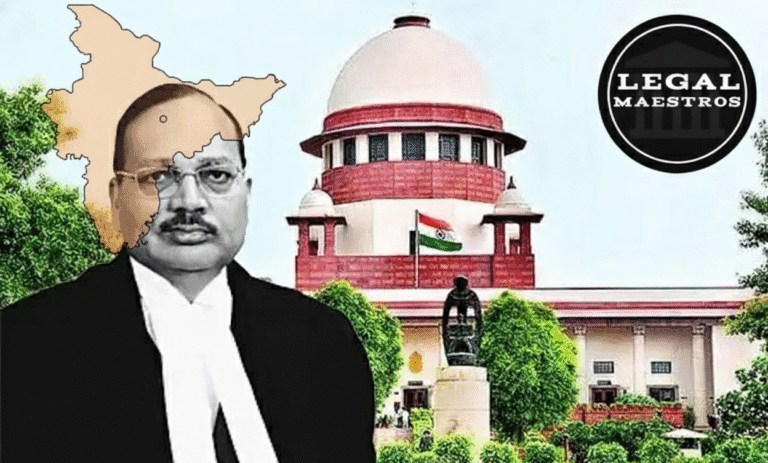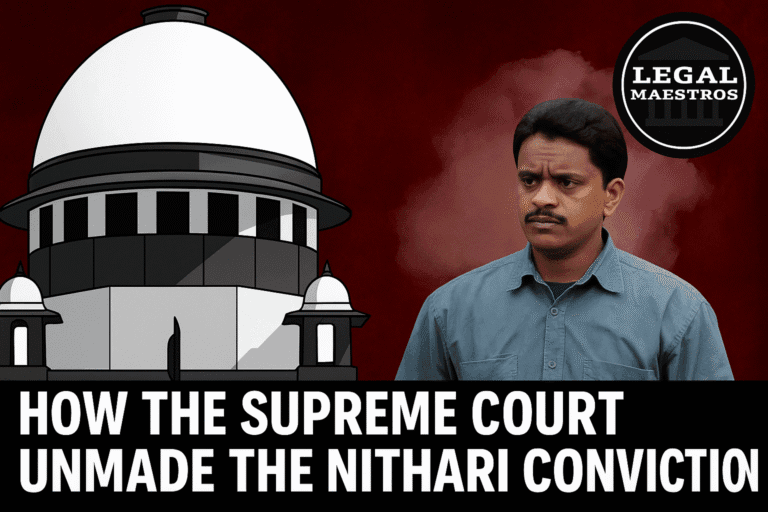
Section 2 Forest (Conservation) Act 1980 Defines Forest Land and Prohibits Unauthorized Diversion
Introduction
Long-standing disagreements regarding parcels of property in six districts of eastern Vidarbha, Nagpur, Wardha, Bhandara, Gondia, Chandrapur, and Gadchiroli, which are referred to in tax records as “Zudpi Jungle” or “Zudpi Forest,” were resolved by the Supreme Court of India on May 22, 2025, in a decision that is considered among the most significant in Indian legal history.
Even though it was designated as forest areas, a significant portion of this land had been utilized for homes, agriculture, public schools, health centers, and government offices for several decades during that time.
For any queries or to publish an article or post or advertisement on our platform, do call at +91 6377460764 or email us at contact@legalmaestros.com.
A petition for relief was submitted to the Supreme Court by the State of Maharashtra, stating that about 86,409 hectares were intrinsically unsuitable for forestry management and therefore not be subject to the limits imposed by the Forest (Conservation) Act, 1980.
Following the publication of extensive reports by the Central Empowered Committee (CEC) and the implementation of several interventions, the Supreme Court issued detailed decisions that struck a balance between the protection of the environment, fundamental rights, and the welfare of the society.
Background information
Historically, the term “Zudpi” comes from the Marathi language and refers to a bushy or scrubby vegetation that occurs on poor, gravelly soils that are not suited for mature tree cover. These lands were assigned in accordance with the Central Province Settlement Code of 1889, and they were subsequently incorporated into the Land Revenue Codes of Madhya Pradesh and Maharashtra.
For any queries or to publish an article or post or advertisement on our platform, do call at +91 6377460764 or email us at contact@legalmaestros.com.
Residents received the rights to graze cattle and harvest minor forest produce under the Nistar system after the dissolution of feudal tenures in 1951. Additionally, local governments constructed schools, hospitals, homes, and public utilities on these lands for the benefit of the community.
Despite this, when the Forest (Conservation) Act was passed in 1980, these regions were made subject to its prohibitions. This resulted in confusion over the legal status of these places, which in turn led to a de facto halt to development efforts.
For More Updates & Regular Notes Join Our Whats App Group (https://chat.whatsapp.com/DkucckgAEJbCtXwXr2yIt0) and Telegram Group ( https://t.me/legalmaestroeducators )
For any queries or to publish an article or post or advertisement on our platform, do call at +91 6377460764 or email us at contact@legalmaestros.com.
The Legal Provisions That Are in Question
The analysis of the Court was dependent on important elements of the statute. According to Section 2 of the Forest (Conservation) Act, 1980, it is against the law for any state or authority to de-reserve forests or use forest land for purposes other than forest management without first receiving clearance from the central government.
In accordance with this rule, “forest land” refers to any land that has been recognized as forest in government records, regardless of the natural qualities of the land. In accordance with Section 29 of the Indian Forest Act of 1927, the state has the authority to designate any area of forest land as a “Protected Forest,” thereby subjecting it to stringent management and protection of the forest.
Additionally, the punitive provisions of Sections 3A and 3B of the Act were invoked, which authorize authorities to be subject to disciplinary action if they facilitate the unauthorized diversion or encroachment of forest, respectively.
For any queries or to publish an article or post or advertisement on our platform, do call at +91 6377460764 or email us at contact@legalmaestros.com.
The Court Takes Into Consideration the Most Fundamental Issues
The Supreme Court examined and settled a number of interconnected problems, including the following:According to the Zudpi Lands, the status is “Forest.”
The Court confirmed that Zudpi lands, notwithstanding their scrubby appearance, are forest lands in accordance with Section 2 of the 1980 Act.
This decision was based on the Court’s decision in 1996 that the term “forest” must be understood by both the dictionary meaning and the records kept by the government. Any use that is not related to forestry that occurs after October 25, 1980 is subject to Central clearance.
For any queries or to publish an article or post or advertisement on our platform, do call at +91 6377460764 or email us at contact@legalmaestros.com.
In spite of this, the Court carved out an exceptional, non-precedential relief that allowed consolidated proposals for delisting those particular parcels without imposing compensatory afforestation or Net Present Value levies. This was done in recognition of the lands’ distinctive history and the predominant non-forest use that occurred prior to December 12, 1996.
The right to protection and a means of subsistence
The Supreme Court, citing Article 21 of the Constitution, which guarantees the right to life and personal liberty, made the observation that housing and agricultural livelihoods that have been established for more than half a century are essential to one’s dignity and ability to survive.
It would be a violation of fundamental rights and a violation of Directive Principles under Articles 38 and 39, which mandate the state to promote social and economic fairness, if people were to be deprived of their homes, farms, and necessary services that were erected on these grounds.
For any queries or to publish an article or post or advertisement on our platform, do call at +91 6377460764 or email us at contact@legalmaestros.com.
As a consequence of this, the Court issued an order that long-standing allotments up until December 12, 1996, be regularized site-specifically, provided that there are no further transfers other than those that occur through inheritance.
The protection of the environment and the promotion of sustainable development
The decision placed an emphasis on sustainable development, which involves striking a balance between the preservation of the environment and the need of the community. Unallotted fragmented parcels, which are plots that are less than three hectares in size and are not continuous with designated forests, were required to be declared Protected Forests in accordance with Section 29 of the 1927 Act.
These Protected Forests were to be managed locally by Sub-Divisional Magistrates in order to prevent encroachment. On the other hand, it mandated that the state hand in streamlined templates for the processing of diversion proposals for operations that were not related to forestry.
For any queries or to publish an article or post or advertisement on our platform, do call at +91 6377460764 or email us at contact@legalmaestros.com.
This was done in conjunction with the Central Government and the CEC. The goal was to ensure that environmental safeguards were maintained without undue procedural costs.
The Implications of Future Regulation and Accountability
In accordance with Sections 3A and 3B of the Forest (Conservation) Act, the Court issued an order that imposed identification and disciplinary action against officials who were responsible for allocations made after 1996 that were not approved by the Central Government.
This was done in order to prevent future unauthorized diversions. In addition, it established concrete deadlines, which included the following: the transfer of all reserved forest lands that were under the custody of the Revenue Department to Forest Departments within three months; the completion of Section 20 notifications under the 1927 Act within six months; and the removal of all post-1980 encroachments and commercial allotments within two years by specially constituted district task forces.
For any queries or to publish an article or post or advertisement on our platform, do call at +91 6377460764 or email us at contact@legalmaestros.com.
The Finalization
The verdict regarding the Zudpi Jungle lands is an example of a subtle endeavor to respect legal safeguards for forests while also protecting the rights and livelihoods of tribes that have occupied and cultivated these lands for generations.
The Supreme Court of the United States maintained the preservation of biological integrity by reiterating the expansive definition of “forest land” as outlined in Section 2 of the Forest (Conservation) Act of 1980 and by utilizing Section 29 of the Indian Forest Act of 1927.
For any queries or to publish an article or post or advertisement on our platform, do call at +91 6377460764 or email us at contact@legalmaestros.com.
At the same time, it honored constitutional guarantees of housing, livelihood, and social justice by implementing site-specific regularization, enforcing timetables, and establishing accountability mechanisms. This well-rounded strategy provides a model for resolving land use conflicts that are comparable to those that occur throughout India.




![JOB POST: Junior Associate at ASM Law Chambers, Jaipur [Freshers]](https://legalmaestros.com/wp-content/uploads/2025/11/Gemini_Generated_Image_8wrxer8wrxer8wrx-768x708.png)


